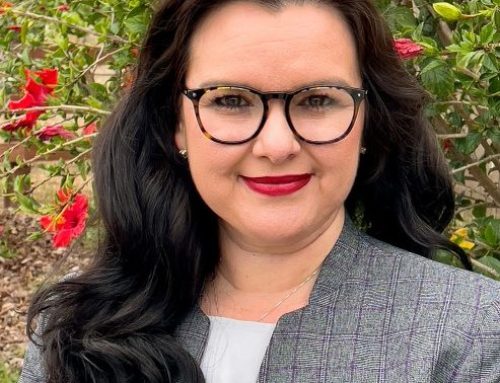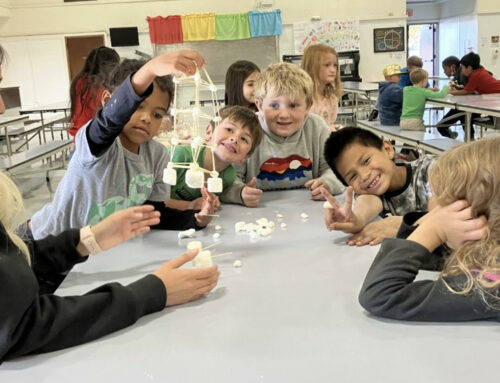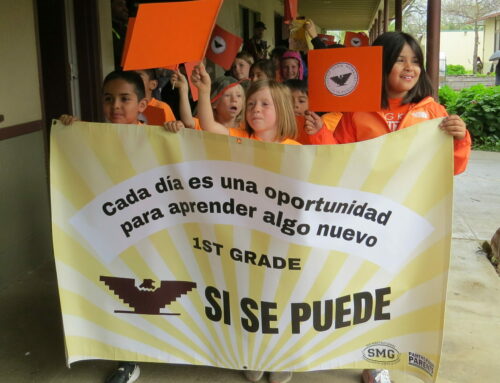Spring Auction raises funds for high school clubs
Published in the April 27 – May 10, 2016 issue of Morgan Hill Life
FOR MORE DETAILS, CLICK HERE
By Marty Cheek

Photo by Marty Cheek
Members of the Future Farmers of America speak to the Morgan Hill Unified School District Board of Trustees.
Wearing the familiar blue corduroy FFA club jackets with “corn gold” colored embroidery, a team of Live Oak and Sobrato high school students showed off their public speaking skills by giving a presentation April 19 to the Morgan Hill Unified School District Board of Trustees about the benefits of belonging to an organization that helps young people achieve personal growth and career success through agricultural education.
For 87 years, Morgan Hill students have learned about farm life and leadership while taking care of animals through training programs done through the Future Farmers of America program, said Michael Ibarra, a senior a Live Oak High School, describing to the board the history of the two local FFA clubs.
“The (national) organization was founded in 1928, and shortly after, like a year after, Morgan Hill Live Oak FFA was founded so we’re in the top 10 clubs in California to be established,” he said. “It wasn’t until 2004 that Sobrato’s (club) was established.”
The Sobrato FFA program’s advisor is ag science teacher Tanya Calabretta and the Live Oak FFA program is advised by ag science teacher Kaiti Whitmyre.

Photo by Marty Cheek
From left: Lauryn Tercero, Patrick O’Neill, Jenna Fields, Mitch Juarez, Danelle Schwegler, Cristian Mendoza, Emmanuel Calivo, Michael Ibarra, and Kamryn Ulloa spoke April 19 to the school board about their FFA activities.
Sobrato FFA Club President Beth Funke said the FFA motto is “Learning to Do, Doing to Learn, Earning to Live, Living to Serve.” The club members gain a deep understanding of this value in everything they do in their club activities, she said.
“We are giving back and serving our community and I think it’s a really great opportunity,” she said.
To help raise money for scholarships for FFA students, the clubs from both campuses are working with the Morgan Hill FFA Alumni Association and Sobrato Ag Booster to co-host their 13th annual Spring Auction.
To be an active member in the National FFA organization, a member must have a “Supervised Agricultural Experience” project, Patrick O’Neil told the board members. There are four areas of SAE projects: “Exploratory” where students learn about the big picture of agriculture and related careers; “Research/Experimentation and Analysis” where they conduct research or analysis of information to discover new knowledge; “Ownership/Entrepreneurship” where they gain knowledge on how to plan and operate of an agriculture-related business; and “Placement” where they work either for pay or experience in an agricultural setting such as a farm or ranch.

“In the FFA, we offer leadership opportunities for students in order for the students to further their leadership skills and develop our public speaking,” said Cristian Mendoza, a sophomore member of the Live Oak club. “All of us are either chapter officers or committee chairs who serve as leadership at every school that offers an FFA program.”
Above the club level are sectional officers who serve a greater geographical area spreading from Campbell to Hollister. Beyond that, students have the opportunity to reach state and even national levels of FFA leadership, he said.
Live Oak Principal Lloyd Webb has witnessed the benefits for students of the FFA clubs at both high school campuses and sees the young people who join grow tremendously through their involvement. During springtime, the students get their livestock animals and have to take care of them seven days a week, learning veterinary care and showmanship so they can compete in front of the judges at the Santa Clara County Fair in August and other venues for agricultural promotion in youth.
“Both campuses have blue ribbon FFA programs. They’re home for close to 150 or 200 kids, offering full college prep courses in the ag sciences, leadership, everything horticulture,” Webb said. “It’s just a great opportunity for the kids to learn so many things.”
ONLINE CORRECTION: According to an FFA club advisor, between the two campuses there are 700 students in FFA and agriculture education.
The FFA programs appeal to a wide range of young people. Kids who are shy often get into FFA and develop poise and confidence, building friendships as they build life skills, he said. Students who go through the program often seek careers in agriculture.
“It appeals to a wide range of kids,” Webb said. “You have kids who for them, that’s their one home in high school and they really love it and that’s fine because it’s so time consuming. From kids who struggle academically all the way up to AP level students, it helps bridge a lot of the peer groups who might not get to know each other, and that’s a really good benefit.”
The students also learn sales and marketing skills and money management strategies by organizing fundraisers during the year to support club activities.
“It’s really like a high school level business for lack of a better term,” Webb said. “If you ever go to their end-of-the-year deal where they swear in the new officers and say goodbye to the old ones, it’s kind of like a joyous ‘wake’ because kids they know so well are leaving. They are phenomenal programs. I’ve had the pleasure to work with both in my two positions in the two schools and, in short, they’re awesome and they do a whole lot for the students and the students learn a lot.”







